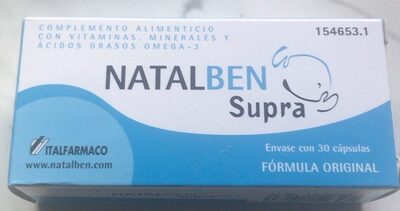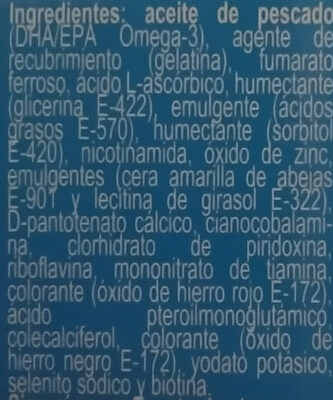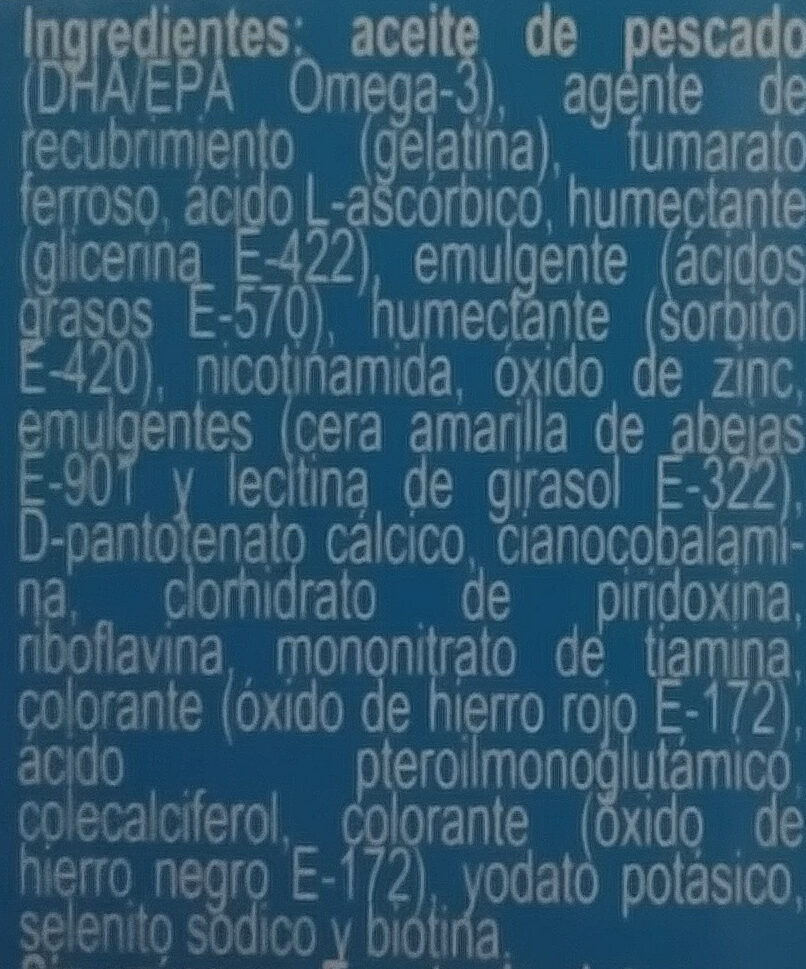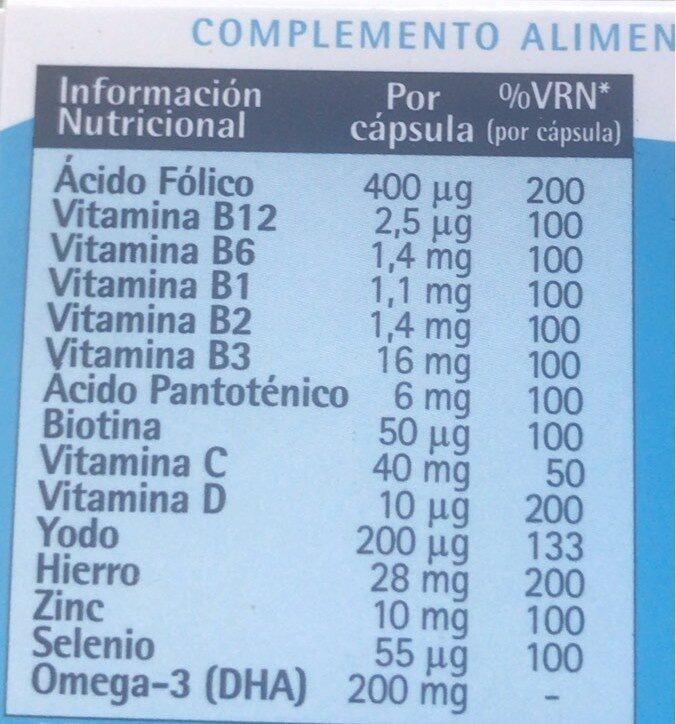Help us make food transparency the norm!
As a non-profit organization, we depend on your donations to continue informing consumers around the world about what they eat.
The food revolution starts with you!
Natalben - Italfarmaco
Natalben - Italfarmaco
This product page is not complete. You can help to complete it by editing it and adding more data from the photos we have, or by taking more photos using the app for Android or iPhone/iPad. Thank you!
×
Barra-kodea: 8470001546531 (EAN / EAN-13)
Markak: Italfarmaco
Kategoriak: es:Medicina
Dendak: Farmacia
Saltzen diren herrialdeak: Espainia
Matching with your preferences
Health
Osagaiak
-
27 ingredients
: aceite de pescado (DHA/EPA Omega-3), agente de recubrimiento (gelatina), ° fumarato ferroso, ácido L-ašcórbiço, humectante (glicenina E-422), emulgente (ácidos grasos E-570), 'humectante (sorbitol E-420), nicotinamida, óxido de zinc, emulgentes (cera amarilla de abejas E-901) y , lecitina de girasol E-322), D-pantotenato cálcico, cianocobalamina, clorhidrato de riboflavina, mononitrato de tiamina çolorante (óxido de hierro rojo E-172) acido çolecalciferol colorante (oxido de hierro negro E-172), yodatò potásico, selenito södico y biótinaAlergenoak: en:Fish
Food processing
-
Ultra processed foods
Elements that indicate the product is in the 4 - Ultra prozesatutako elikagaiak eta edariak group:
- Gehigarria: E172
- Gehigarria: E322
- Gehigarria: E420
- Gehigarria: E428 - Gelatina
- Gehigarria: E901 - Erle-argizari
- Osagaia: Emulsifier
- Osagaia: Glazing agent
- Osagaia: Humectant
Food products are classified into 4 groups according to their degree of processing:
- Prozesatu gabeko edo ahalik eta gutxien prozesatutako elikagaiak
- Sukaldaritzako osagaiak prozesatu
- Prozesatutako jakiak
- Ultra processed foods
The determination of the group is based on the category of the product and on the ingredients it contains.
Gehigarriak
-
E322
Lecithin: Lecithin -UK: , US: , from the Greek lekithos, "egg yolk"- is a generic term to designate any group of yellow-brownish fatty substances occurring in animal and plant tissues, which are amphiphilic – they attract both water and fatty substances -and so are both hydrophilic and lipophilic-, and are used for smoothing food textures, dissolving powders -emulsifying-, homogenizing liquid mixtures, and repelling sticking materials.Lecithins are mixtures of glycerophospholipids including phosphatidylcholine, phosphatidylethanolamine, phosphatidylinositol, phosphatidylserine, and phosphatidic acid.Lecithin was first isolated in 1845 by the French chemist and pharmacist Theodore Gobley. In 1850, he named the phosphatidylcholine lécithine. Gobley originally isolated lecithin from egg yolk—λέκιθος lekithos is "egg yolk" in Ancient Greek—and established the complete chemical formula of phosphatidylcholine in 1874; in between, he had demonstrated the presence of lecithin in a variety of biological matters, including venous blood, in human lungs, bile, human brain tissue, fish eggs, fish roe, and chicken and sheep brain. Lecithin can easily be extracted chemically using solvents such as hexane, ethanol, acetone, petroleum ether, benzene, etc., or extraction can be done mechanically. It is usually available from sources such as soybeans, eggs, milk, marine sources, rapeseed, cottonseed, and sunflower. It has low solubility in water, but is an excellent emulsifier. In aqueous solution, its phospholipids can form either liposomes, bilayer sheets, micelles, or lamellar structures, depending on hydration and temperature. This results in a type of surfactant that usually is classified as amphipathic. Lecithin is sold as a food additive and dietary supplement. In cooking, it is sometimes used as an emulsifier and to prevent sticking, for example in nonstick cooking spray.Source: Wikipedia (Ingeles)
-
E322i - Lezitina
Lecithin: Lecithin -UK: , US: , from the Greek lekithos, "egg yolk"- is a generic term to designate any group of yellow-brownish fatty substances occurring in animal and plant tissues, which are amphiphilic – they attract both water and fatty substances -and so are both hydrophilic and lipophilic-, and are used for smoothing food textures, dissolving powders -emulsifying-, homogenizing liquid mixtures, and repelling sticking materials.Lecithins are mixtures of glycerophospholipids including phosphatidylcholine, phosphatidylethanolamine, phosphatidylinositol, phosphatidylserine, and phosphatidic acid.Lecithin was first isolated in 1845 by the French chemist and pharmacist Theodore Gobley. In 1850, he named the phosphatidylcholine lécithine. Gobley originally isolated lecithin from egg yolk—λέκιθος lekithos is "egg yolk" in Ancient Greek—and established the complete chemical formula of phosphatidylcholine in 1874; in between, he had demonstrated the presence of lecithin in a variety of biological matters, including venous blood, in human lungs, bile, human brain tissue, fish eggs, fish roe, and chicken and sheep brain. Lecithin can easily be extracted chemically using solvents such as hexane, ethanol, acetone, petroleum ether, benzene, etc., or extraction can be done mechanically. It is usually available from sources such as soybeans, eggs, milk, marine sources, rapeseed, cottonseed, and sunflower. It has low solubility in water, but is an excellent emulsifier. In aqueous solution, its phospholipids can form either liposomes, bilayer sheets, micelles, or lamellar structures, depending on hydration and temperature. This results in a type of surfactant that usually is classified as amphipathic. Lecithin is sold as a food additive and dietary supplement. In cooking, it is sometimes used as an emulsifier and to prevent sticking, for example in nonstick cooking spray.Source: Wikipedia (Ingeles)
-
E420
Sorbitol: Sorbitol --, less commonly known as glucitol --, is a sugar alcohol with a sweet taste which the human body metabolizes slowly. It can be obtained by reduction of glucose, which changes the aldehyde group to a hydroxyl group. Most sorbitol is made from corn syrup, but it is also found in nature, for example in apples, pears, peaches, and prunes. It is converted to fructose by sorbitol-6-phosphate 2-dehydrogenase. Sorbitol is an isomer of mannitol, another sugar alcohol; the two differ only in the orientation of the hydroxyl group on carbon 2. While similar, the two sugar alcohols have very different sources in nature, melting points, and uses.Source: Wikipedia (Ingeles)
-
E507
Hydrochloric acid: Hydrochloric acid is a colorless inorganic chemical system with the formula H2O:HCl. Hydrochloric acid has a distinctive pungent smell. It is mainly produced as a precursor to vinyl chloride for PVC. It is classified as strongly acidic and can attack the skin over a wide composition range, since the hydrogen chloride practically dissociates completely in solution. Hydrochloric acid is the simplest chlorine-based acid system containing water. It consists of hydrogen chloride and water, and a variety of other chemical species, including hydronium and chloride ions. It is an important chemical reagent and industrial chemical, used primarily in the production of polyvinyl chloride for plastic. In households, diluted hydrochloric acid is often used as a descaling agent. In the food industry, hydrochloric acid used as a food additive and in the production of gelatin. Hydrochloric acid is also used in leather processing. Hydrochloric acid was discovered by the alchemist Jabir ibn Hayyan around the year 800 AD. Hydrochloric acid was historically called acidum salis, muriatic acid, and spirits of salt because it was produced from rock salt and "green vitriol" -IronII sulfate- -by Basilius Valentinus in the 15th century- and later from the chemically similar common salt and sulfuric acid -by Johann Rudolph Glauber in the 17th century-. Free hydrochloric acid was first formally described in the 16th century by Libavius. Later, it was used by chemists such as Glauber, Priestley, and Davy in their scientific research. Unless pressurized or cooled, hydrochloric acid will turn into a gas if there is around 60% or less of water. Hydrochloric acid is also known as hydronium chloride.Source: Wikipedia (Ingeles)
-
E570
Fatty acid: In chemistry, particularly in biochemistry, a fatty acid is a carboxylic acid with a long aliphatic chain, which is either saturated or unsaturated. Most naturally occurring fatty acids have an unbranched chain of an even number of carbon atoms, from 4 to 28. Fatty acids are usually not found per se in organisms, but instead as three main classes of esters: triglycerides, phospholipids, and cholesterol esters. In any of these forms, fatty acids are both important dietary sources of fuel for animals and they are important structural components for cells.Source: Wikipedia (Ingeles)
-
E901 - Erle-argizari
Beeswax: Beeswax -cera alba- is a natural wax produced by honey bees of the genus Apis. The wax is formed into "scales" by eight wax-producing glands in the abdominal segments of worker bees, which discard it in or at the hive. The hive workers collect and use it to form cells for honey storage and larval and pupal protection within the beehive. Chemically, beeswax consists mainly of esters of fatty acids and various long-chain alcohols. Beeswax has long-standing applications in human food and flavoring. For example, it is used as a glazing agent or as a light/heat source. It is edible, in the sense of having similar negligible toxicity to plant waxes, and is approved for food use in most countries and the European Union under the E number E901. However, the wax monoesters in beeswax are poorly hydrolysed in the guts of humans and other mammals, so they have insignificant nutritional value. Some birds, such as honeyguides, can digest beeswax. Beeswax is the main diet of wax moth larvae.Source: Wikipedia (Ingeles)
Ingredients analysis
-
en:Palm oil content unknown
Unrecognized ingredients: es:dha, es:epa-omega-3, es:acido-l-ašcorbico, es:glicenina-e422, es:lecitina-de-girasol-e322, es:clorhidrato-de-riboflavina, es:mononitrato-de-tiamina-colorante, es:oxido-de-hierro-rojo-e172, es:acido-colecalciferol-colorante, es:oxido-de-hierro-negro-e172, es:selenito-sodico-y-biotinaSome ingredients could not be recognized.
We need your help!
You can help us recognize more ingredients and better analyze the list of ingredients for this product and others:
- Edit this product page to correct spelling mistakes in the ingredients list, and/or to remove ingredients in other languages and sentences that are not related to the ingredients.
- Add new entries, synonyms or translations to our multilingual lists of ingredients, ingredient processing methods, and labels.
If you would like to help, join the #ingredients channel on our Slack discussion space and/or learn about ingredients analysis on our wiki. Thank you!
-
en:Non-vegan
Non-vegan ingredients: en:Fish oil, E428, E901Some ingredients could not be recognized.
We need your help!
You can help us recognize more ingredients and better analyze the list of ingredients for this product and others:
- Edit this product page to correct spelling mistakes in the ingredients list, and/or to remove ingredients in other languages and sentences that are not related to the ingredients.
- Add new entries, synonyms or translations to our multilingual lists of ingredients, ingredient processing methods, and labels.
If you would like to help, join the #ingredients channel on our Slack discussion space and/or learn about ingredients analysis on our wiki. Thank you!
-
en:Non-vegetarian
Non-vegetarian ingredients: en:Fish oil, E428Some ingredients could not be recognized.
We need your help!
You can help us recognize more ingredients and better analyze the list of ingredients for this product and others:
- Edit this product page to correct spelling mistakes in the ingredients list, and/or to remove ingredients in other languages and sentences that are not related to the ingredients.
- Add new entries, synonyms or translations to our multilingual lists of ingredients, ingredient processing methods, and labels.
If you would like to help, join the #ingredients channel on our Slack discussion space and/or learn about ingredients analysis on our wiki. Thank you!
-
Details of the analysis of the ingredients
We need your help!
Some ingredients could not be recognized.
We need your help!
You can help us recognize more ingredients and better analyze the list of ingredients for this product and others:
- Edit this product page to correct spelling mistakes in the ingredients list, and/or to remove ingredients in other languages and sentences that are not related to the ingredients.
- Add new entries, synonyms or translations to our multilingual lists of ingredients, ingredient processing methods, and labels.
If you would like to help, join the #ingredients channel on our Slack discussion space and/or learn about ingredients analysis on our wiki. Thank you!
: aceite de pescado (DHA, EPA Omega-3), agente de recubrimiento (gelatina), ° fumarato ferroso, ácido L-ašcórbiço, humectante (glicenina e422), emulgente (ácidos grasos e570), humectante (sorbitol e420), nicotinamida, óxido de zinc, emulgentes (cera amarilla de abejas e901), lecitina de girasol e322, D-pantotenato cálcico, cianocobalamina, clorhidrato de riboflavina, mononitrato de tiamina çolorante (óxido de hierro rojo e172), acido çolecalciferol colorante (oxido de hierro negro e172), yodatò potásico, selenito södico y biótina- aceite de pescado -> en:fish-oil - vegan: no - vegetarian: no - from_palm_oil: no - percent_min: 5.55555555555556 - percent_max: 100
- DHA -> es:dha - percent_min: 2.77777777777778 - percent_max: 100
- EPA Omega-3 -> es:epa-omega-3 - percent_min: 0 - percent_max: 50
- agente de recubrimiento -> en:glazing-agent - percent_min: 0 - percent_max: 50
- gelatina -> en:e428 - vegan: no - vegetarian: no - percent_min: 0 - percent_max: 50
- ° fumarato ferroso -> en:iron-fumarate - percent_min: 0 - percent_max: 33.3333333333333
- ácido L-ašcórbiço -> es:acido-l-ašcorbico - percent_min: 0 - percent_max: 25
- humectante -> en:humectant - percent_min: 0 - percent_max: 20
- glicenina e422 -> es:glicenina-e422 - percent_min: 0 - percent_max: 20
- emulgente -> en:emulsifier - percent_min: 0 - percent_max: 16.6666666666667
- ácidos grasos e570 -> en:e570 - vegan: maybe - vegetarian: maybe - percent_min: 0 - percent_max: 16.6666666666667
- humectante -> en:humectant - percent_min: 0 - percent_max: 14.2857142857143
- sorbitol e420 -> en:e420 - vegan: yes - vegetarian: yes - percent_min: 0 - percent_max: 14.2857142857143
- nicotinamida -> en:e375 - vegan: maybe - vegetarian: maybe - percent_min: 0 - percent_max: 12.5
- óxido de zinc -> en:zinc-oxide - percent_min: 0 - percent_max: 11.1111111111111
- emulgentes -> en:emulsifier - percent_min: 0 - percent_max: 10
- cera amarilla de abejas e901 -> en:e901 - vegan: no - vegetarian: yes - percent_min: 0 - percent_max: 10
- lecitina de girasol e322 -> es:lecitina-de-girasol-e322 - percent_min: 0 - percent_max: 9.09090909090909
- D-pantotenato cálcico -> en:d-pantothenate-calcium - vegan: yes - vegetarian: yes - percent_min: 0 - percent_max: 8.33333333333333
- cianocobalamina -> en:cyanocobalamin - percent_min: 0 - percent_max: 7.69230769230769
- clorhidrato de riboflavina -> es:clorhidrato-de-riboflavina - percent_min: 0 - percent_max: 7.14285714285714
- mononitrato de tiamina çolorante -> es:mononitrato-de-tiamina-colorante - percent_min: 0 - percent_max: 6.66666666666667
- óxido de hierro rojo e172 -> es:oxido-de-hierro-rojo-e172 - percent_min: 0 - percent_max: 6.66666666666667
- acido çolecalciferol colorante -> es:acido-colecalciferol-colorante - percent_min: 0 - percent_max: 6.25
- oxido de hierro negro e172 -> es:oxido-de-hierro-negro-e172 - percent_min: 0 - percent_max: 6.25
- yodatò potásico -> en:e917 - vegan: yes - vegetarian: yes - percent_min: 0 - percent_max: 5.88235294117647
- selenito södico y biótina -> es:selenito-sodico-y-biotina - percent_min: 0 - percent_max: 5.55555555555556
Elikadura
-
Average nutritional quality
⚠ ️Warning: the amount of fruits, vegetables and nuts is not specified on the label, it was estimated from the list of ingredients: 0This product is not considered a beverage for the calculation of the Nutri-Score.
Positive points: 0
- Proteinak: 0 / 5 (balioa: 0, rounded value: 0)
- Fiber: 0 / 5 (balioa: 0, rounded value: 0)
- Fruits, vegetables, nuts, and colza/walnut/olive oils: 0 / 5 (balioa: 0, rounded value: 0)
Negative points: 10
- Energia: 0 / 10 (balioa: 0, rounded value: 0)
- Azukreak: 0 / 10 (balioa: 0, rounded value: 0)
- Gantz saturatua: 0 / 10 (balioa: 0, rounded value: 0)
- Sodioa: 10 / 10 (balioa: 1200, rounded value: 1200)
The points for proteins are counted because the negative points are less than 11.
Nutritional score: (10 - 0)
Nutri-Score:
-
Nutrient levels
-
Koipe in low quantity (0%)
What you need to know- A high consumption of fat, especially saturated fats, can raise cholesterol, which increases the risk of heart diseases.
Recommendation: Limit the consumption of fat and saturated fat- Choose products with lower fat and saturated fat content.
-
Gantz-azido ase in low quantity (0%)
What you need to know- A high consumption of fat, especially saturated fats, can raise cholesterol, which increases the risk of heart diseases.
Recommendation: Limit the consumption of fat and saturated fat- Choose products with lower fat and saturated fat content.
-
Azukre in low quantity (0%)
What you need to know- A high consumption of sugar can cause weight gain and tooth decay. It also augments the risk of type 2 diabetes and cardio-vascular diseases.
Recommendation: Limit the consumption of sugar and sugary drinks- Sugary drinks (such as sodas, fruit beverages, and fruit juices and nectars) should be limited as much as possible (no more than 1 glass a day).
- Choose products with lower sugar content and reduce the consumption of products with added sugars.
-
Gatz arrunt in high quantity (3%)
What you need to know- A high consumption of salt (or sodium) can cause raised blood pressure, which can increase the risk of heart disease and stroke.
- Many people who have high blood pressure do not know it, as there are often no symptoms.
- Most people consume too much salt (on average 9 to 12 grams per day), around twice the recommended maximum level of intake.
Recommendation: Limit the consumption of salt and salted food- Reduce the quantity of salt used when cooking, and don't salt again at the table.
- Limit the consumption of salty snacks and choose products with lower salt content.
-
-
Nutrition facts
Nutrition facts As sold
for 100 g / 100 mlEnergia 0 kj
(0 kcal)Koipe 0 g Gantz-azido ase 0 g Carbohydrates 0 g Azukre 0 g Fiber 0 g Proteina 0 g Gatz arrunt 3 g Fruits‚ vegetables‚ nuts and rapeseed‚ walnut and olive oils (estimate from ingredients list analysis) 0 %
Ingurumena
-
Eco-Score not computed - Unknown environmental impact
We could not compute the Eco-Score of this product as it is missing some data, could you help complete it?Could you add a precise product category so that we can compute the Eco-Score? Add a category
Ontziratzea
-
Missing packaging information for this product
⚠ ️ The information about the packaging of this product is not filled in.Take a photo of the recycling information Take a photo of the recycling information
Transportation
-
Origins of ingredients
Missing origins of ingredients information
⚠ ️ The origins of the ingredients of this product are not indicated.
If they are indicated on the packaging, you can modify the product sheet and add them.
If you are the manufacturer of this product, you can send us the information with our free platform for producers.Add the origins of ingredients for this product Add the origins of ingredients for this product
Report a problem
-
Incomplete or incorrect information?
Category, labels, ingredients, allergens, nutritional information, photos etc.
If the information does not match the information on the packaging, please complete or correct it. Open Food Facts is a collaborative database, and every contribution is useful for all.
Datuen iturria
Product added on by kiliweb
Last edit of product page on by kiliweb.
Produktuaren orria -gatik editatua acuario, inf, nivo, thaialagata, yuka.ZEswWUhmUlptL1FzeDlvbHdocjNvTnR4OXBDSlFYdXZBY2toSVE9PQ, yuka.sY2b0xO6T85zoF3NwEKvlhAWU8LU_D_7EQfWqROV94e8JcO3Tfptv5PZKKs, yuka.sY2b0xO6T85zoF3NwEKvlmVrCf-EkCnjJQLjk2eF4vS8C83VW_1s6ZGjLKg.










